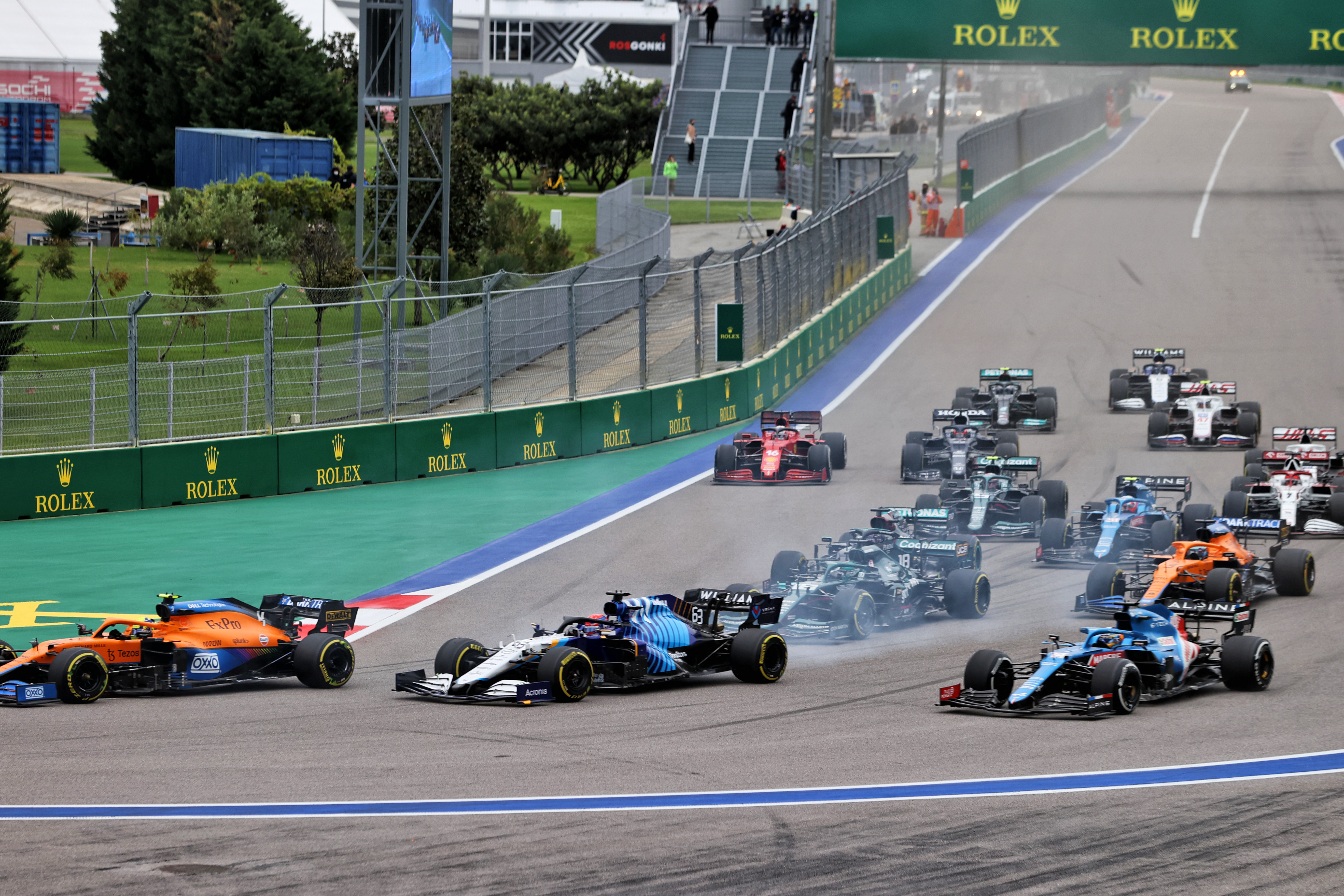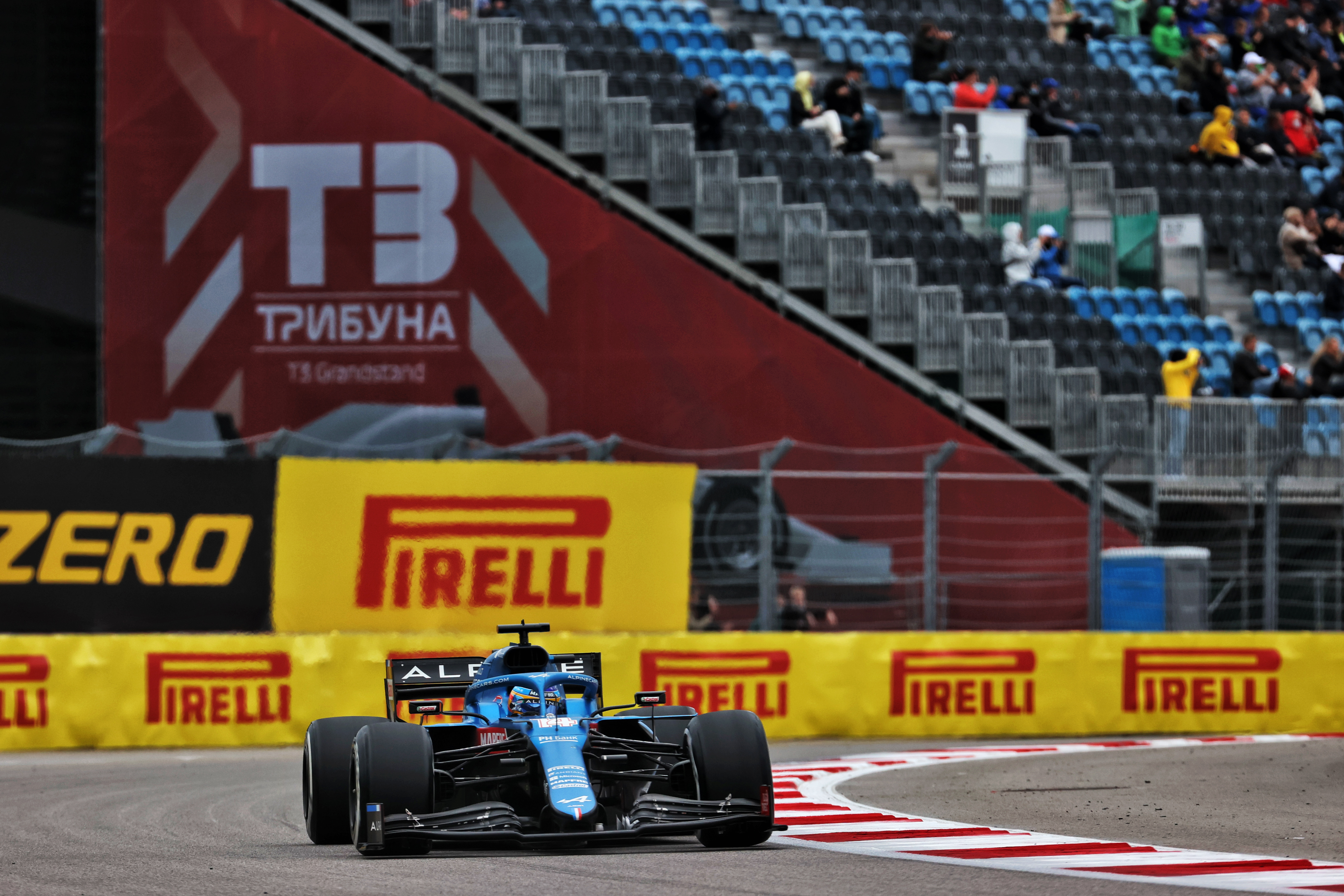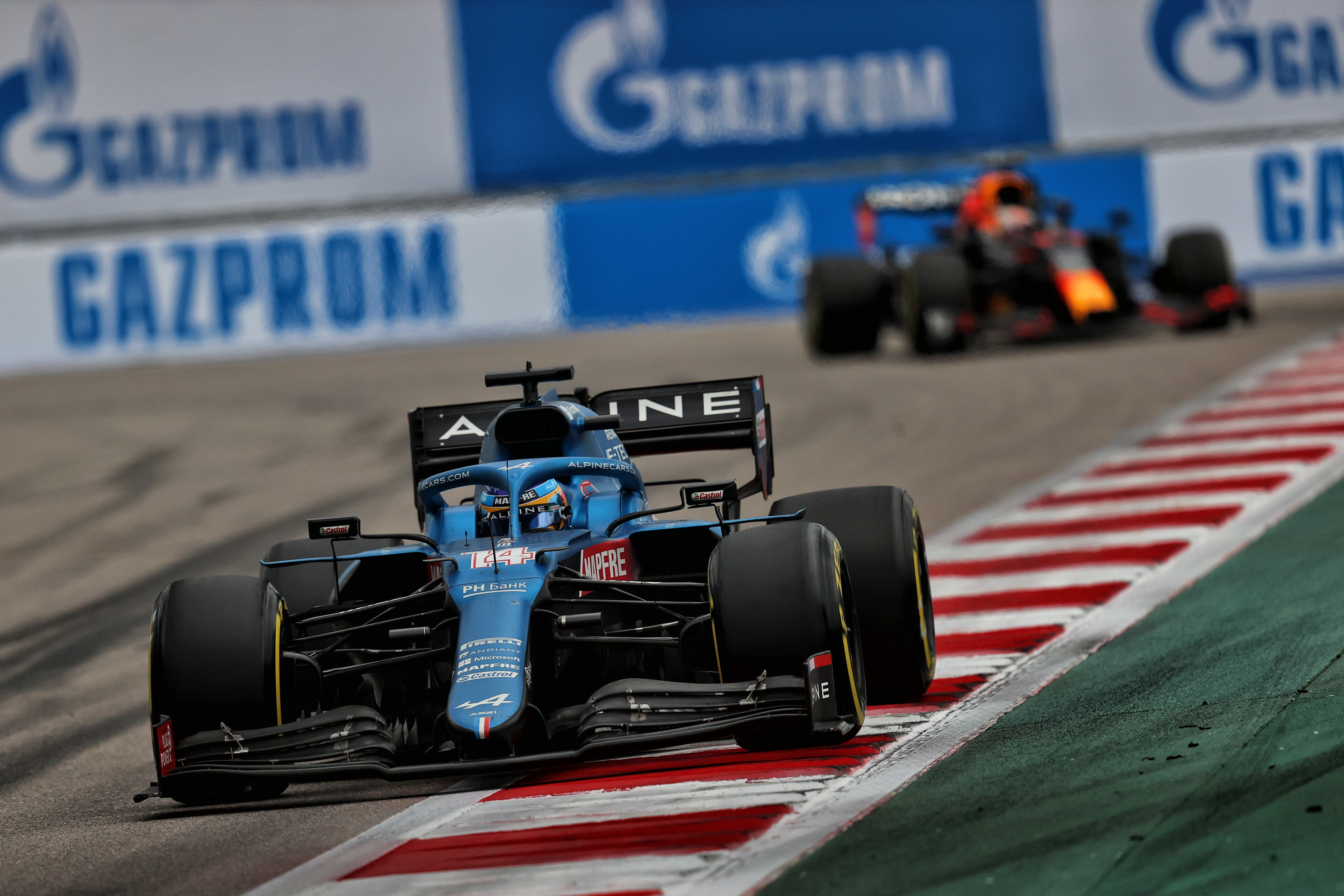Up Next

When Fernando Alonso flew across the Turn 2 run-off area and rejoined in fourth place on the opening lap of the Russian Grand Prix, many questioned why no action was taken against the Alpine driver for the perceived advantage he gained given the speed he carried and how early he committed.
The FIA stewards noted that four drivers, Alonso plus Pierre Gasly, Antonio Giovinazzi and Max Verstappen, all used the run-off area on the first lap but quickly deemed it was unnecessary to investigate the incidents.
Given Alonso was spotted by Sky Sports F1’s Karun Chandhok practising the manoeuvre on a reconnaissance lap before the race, it was clear that the idea of doing so was on his mind prior to the start.
Those who recall Alonso’s complaints about the advantage gained by rivals earlier in the season, notably in the two races at the Red Bull Ring where he said he was made to “feel a little bit stupid” by losing out to rivals who used the run-off, might be tempted to accuse him of hypocrisy.
But having raised objections earlier this season, including in drivers’ briefings, he has correctly decided to use the rules to his advantage, as he is completely entitled to.
To understand why, you have to consider the two rules – one written and one simply agreed between the drivers and race director Michael Masi.

The first is in the race directors’ notes, which are issued at each grand prix. For Sochi, this stated that “each time any car fails to negotiate Turn 2 by using the track and has any part of the car over the first orange kerb element prior to the apex, or passes completely to the left of the orange apex sausage at Turn 2, they must then rejoin the track by driving around the array of blocks as indicated by the arrows before then rejoining the track at Turn 2”.
Alonso fulfilled that criteria as he did run around the “array of blocks” that effectively constitute a chicane before rejoining the track and racing on. So, indeed, did the other three drivers – although Gasly didn’t do so entirely successfully as he took a chunk out of one of them while doing so.
The second is an unwritten rule, one of the many necessary deviations from the letter of the general-purpose regulations to deal with specific and is known by all drivers and teams.
This is that when drivers do this in the early corners of races at tracks where there are potential gains to be made, they are obliged to rejoin behind the driver that they were behind when they left the track. In Alonso’s case, that was George Russell, who he did indeed slot in behind.
“He didn’t get away with it,” said Masi when asked about this after the race.
“The teams are well and truly aware of this. On the first couple of turns of any race, if there are areas like that the drivers need to get back behind the driver that they entered behind, which Fernando did, very quickly, as did the other three drivers that went off there.”

Masi said that this rule was introduced at the drivers’ behest following the 2019 French Grand Prix at Paul Ricard after Racing Point driver Sergio Perez cut across the run-off area in the Turn 3-5 right/left/right sequence and gained an advantage.
In that instance, Perez did cut around a bollard marking the required route for rejoining, but still gained positions. This meant he was given a five-second penalty.
“From that point forward, for the first few corners where that happens, either the team automatically tells them to give the position back to where they entered the corner or I would suggest it,” said Masi.
“We looked at all four of those that went off today and all four did exactly that, which is why it was up there as noted immediately and once we looked at all of them there was no investigation necessary.”
Given the way the rules are laid out and enforced, what Alonso did was entirely fair. These rules apply to all 20 drivers, so it is a level playing field and Alonso is perfectly entitled to do what he did.
However, while the rule saying you must slot in after the car you were originally behind when you rejoined is a logical one insofar as it is easy to define where the driver should be, there is scope for taking advantage of this rule. Quite rightly, Alonso has identified this as a way to make gains at the start – but not by the act of cutting across the run-off area itself.

it is understood Alonso had talked about this situation before the race with his team. Knowing that the run-off area is available, it’s possible for a driver to commit to the outside line approaching Turn 2, which can be a strategy that backfires given the profile of Turn 2 thanks to it narrowing due to the second part of the corner sometimes referred to as Turn 2A.
But with the run-off rule as it is, Alonso was able to commit to the outside, get up to fourth behind Russell and then immediately commit to the run-off without the risk of either contact or being hung out to dry on the outside line in the narrowing corner.
The genius of Alonso’s approach was to realise the potential advantage of this as it effectively eliminates the risk of being on the outside line and allowed him to gain positions simply based on where he was entering the corner.
This is absolutely in keeping with the rules and an intelligent way to approach the start, although could become problematic in the future if too many drivers attempt to take advantage of it. But that’s not a problem for Alonso to solve, it’s down to the rulemakers and race director to ensure it is kept under control.
After all, Alonso can quite justifiably point out that he has raised objections to the way run-off is policed at the start of races, so he has every right to take advantage of it given he feels he has been disadvantaged at the start.
In this case, the strategy didn’t pay off as well as it might have done, but only because Alonso lost two positions later in the lap, the first of those being to Stroll at Turn 4.
But it does show a potential limitation of what is otherwise a practical and easy to apply rule given that at certain tracks it does allow a certain degree of premeditation and allow a driver to gain simply by their position into the corner without having to go through it.
Podium was possible on merit

Alonso also suggested he deserved to finish third at Sochi after a strong race given his performance on slicks in the damp before the second bank of rain hit and made the track undriveable for those still not on intermediates.
He was sixth when the rain initially came, having earlier overtaken Max Verstappen just after his pitstop. While still on slicks in the damp, Alonso was impressively quick and overtook Daniel Ricciardo, Carlos Sainz and Perez in the three laps before the second bank of rain swept in and made the track undriveable without intermediate rubber.
Without that second weather front, Alonso’s decision to stay out on slicks would have been the right one and earned him his first F1 podium since the 2014 Hungarian Grand Prix.
“It was a good race for us, the best race of the year in terms of performance,” said Alonso. who eventually finished sixth.
“The car felt very fast, had a good balance throughout the race. We were keeping up the pace with Checo [Perez] in the first stint, then we switched to the medium tyre and we were able to overtake Verstappen and pull away from him.
“Then it started drizzling a little bit on dry tyres and we overtook Daniel, Checo and Sainz and we were P3. So I think the podium was possible today on merit.
6-5-4-3 Caramba ! @AlpineF1Team was mega fast yesterday! It was fun 😈😇. pic.twitter.com/28I1rdYq6P
— Fernando Alonso (@alo_oficial) September 27, 2021
“The car was flying and I was very happy, but unfortunately the rain came with five laps to the end. Some people took some risks, other people other risks and we were unlucky.
“But in these conditions, it’s always a lottery and in normal conditions we were good, so I’m happy.”
Alonso was particularly impressed with the speed of the car in dry conditions and hopes Alpine can build on this showing.
“On the car, we need to take a look,” said Alonso when asked if Alpine had unlocked some performance from the car that would carry over into future races.
“We seemed ultra-competitive today, so we need to understand if we did something different here and try to take forward for the next events, because the car was very fast, so that was a very positive sign.
“We should have been on the podium in terms of executing the race and driving. We were in front of Verstappen, we were pulling away from him, we were in front of Sainz.
“[Lando] Norris did an amazing race and just by luck he’s not had his first-ever win in Formula 1. When it rains, it’s a luck factor, and I’m sad because when we are not competitive and we are P11 or P12 it never rained, so we never get lucky.
“And when we were P3 it just rained. Definitely, we are not very lucky.”








